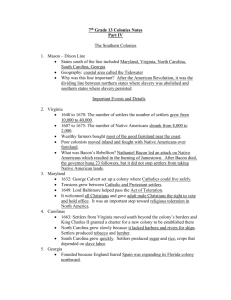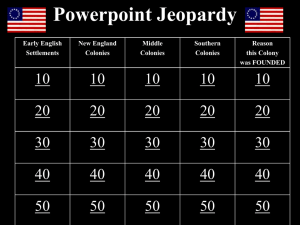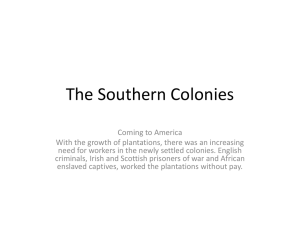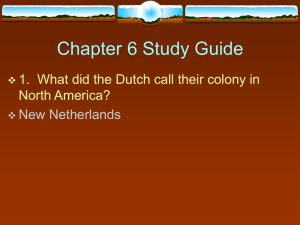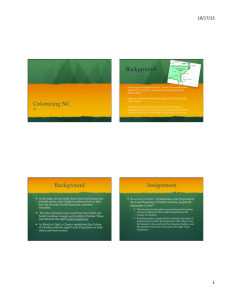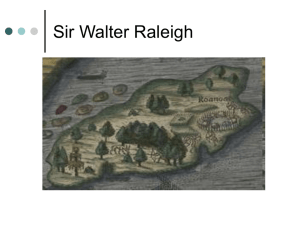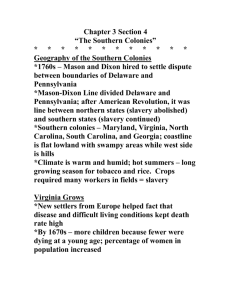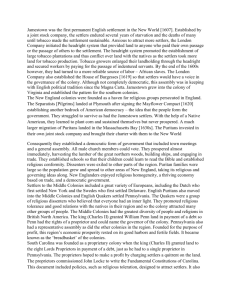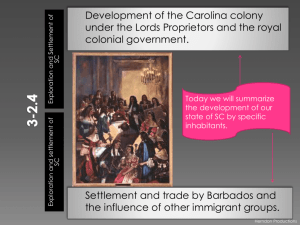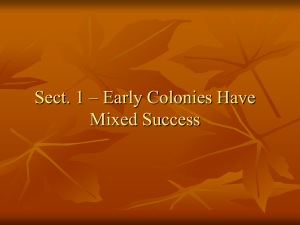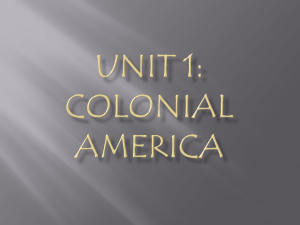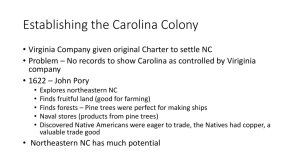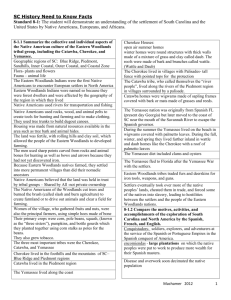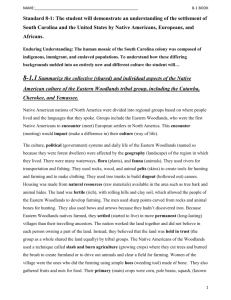Standard 8-1: The student will demonstrate an understanding of the
advertisement
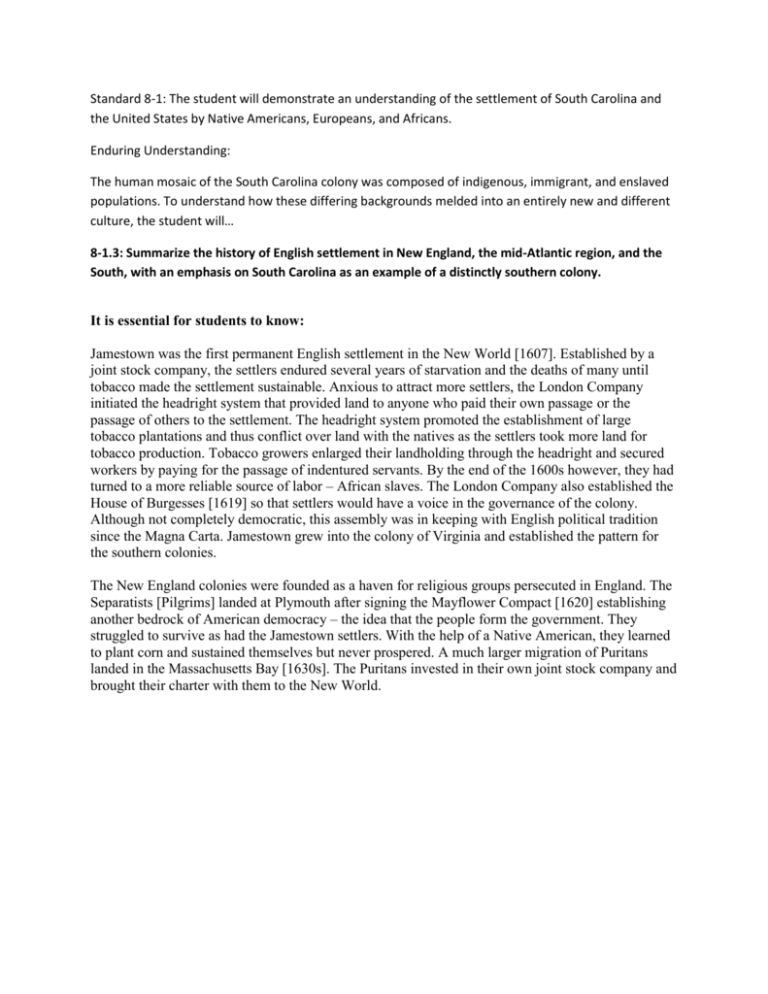
Standard 8-1: The student will demonstrate an understanding of the settlement of South Carolina and the United States by Native Americans, Europeans, and Africans. Enduring Understanding: The human mosaic of the South Carolina colony was composed of indigenous, immigrant, and enslaved populations. To understand how these differing backgrounds melded into an entirely new and different culture, the student will… 8-1.3: Summarize the history of English settlement in New England, the mid-Atlantic region, and the South, with an emphasis on South Carolina as an example of a distinctly southern colony. It is essential for students to know: Jamestown was the first permanent English settlement in the New World [1607]. Established by a joint stock company, the settlers endured several years of starvation and the deaths of many until tobacco made the settlement sustainable. Anxious to attract more settlers, the London Company initiated the headright system that provided land to anyone who paid their own passage or the passage of others to the settlement. The headright system promoted the establishment of large tobacco plantations and thus conflict over land with the natives as the settlers took more land for tobacco production. Tobacco growers enlarged their landholding through the headright and secured workers by paying for the passage of indentured servants. By the end of the 1600s however, they had turned to a more reliable source of labor – African slaves. The London Company also established the House of Burgesses [1619] so that settlers would have a voice in the governance of the colony. Although not completely democratic, this assembly was in keeping with English political tradition since the Magna Carta. Jamestown grew into the colony of Virginia and established the pattern for the southern colonies. The New England colonies were founded as a haven for religious groups persecuted in England. The Separatists [Pilgrims] landed at Plymouth after signing the Mayflower Compact [1620] establishing another bedrock of American democracy – the idea that the people form the government. They struggled to survive as had the Jamestown settlers. With the help of a Native American, they learned to plant corn and sustained themselves but never prospered. A much larger migration of Puritans landed in the Massachusetts Bay [1630s]. The Puritans invested in their own joint stock company and brought their charter with them to the New World. Consequently they established a democratic form of government that included town meetings and a general assembly. All male church members could vote. They prospered almost immediately, harvesting the lumber of the great northern woods, building ships, and engaging in trade. They established schools so that their children could learn to read the Bible and established religious conformity. Dissenters were exiled to other parts of the region. Puritan families were large so the population grew and spread to other areas of New England, taking its religious and governing ideas along. New Englanders enjoyed religious homogeneity, a thriving economy based on trade, and a democratic government. Settlers to the Middle Colonies included a great variety of Europeans, including the Dutch who first settled New York and the Swedes who first settled Delaware. English Puritans also moved into the Middle Colonies and English Quakers settled Pennsylvania. The Quakers were a group of religious dissenters who believed that everyone had an inner light. They promoted religious tolerance and good relations with the natives in their region and so the colony attracted many other groups of people. The Middle Colonies had the greatest diversity of people and religions in British North America. The king (Charles II) granted William Penn land in payment of a debt so Penn had the rights of a proprietor and could name the governor of the colony. Pennsylvania also had a representative assembly as did the other colonies in the region. Founded for the purpose of profit, this region’s economic prosperity rested on its good harbors and fertile fields. It became known as the ‘breadbasket’ of the colonies. South Carolina was founded as a proprietary colony when the king (Charles II) granted land to the eight Lords Proprietors in payment of a debt, just as he had to a single proprietor in Pennsylvania. The proprietors hoped to make a profit by charging settlers a quitrent on the land. The proprietors commissioned John Locke to write the Fundamental Constitutions of Carolina. This document included policies, such as religious toleration, designed to attract settlers. It also included provisions for establishing a social class system based on the granting of titles to large landholders. Although this provision was never carried out, it shows the intention to make Carolina a society based on deference to the elites, unlike the experiences in New England and the middle colonies where religion at first emphasized equality. In order to encourage immigration, the proprietors granted large tracts of land to settlers through the headright system, just as in Virginia. The headright system led to the establishment of large plantations based on cash crops that made South Carolina a distinctly southern colony. The first settlers were Englishmen who emigrated from the British colony of Barbados and brought a well-developed slave system with them (8-1.4). Slavery made the plantation owners very wealthy (8-1.5). Other settlers attracted to the prosperous colony came from France, Switzerland, Germany, Scotland, and Ireland. Assured of religious choice by the Fundamental Constitutions, settlers came from diverse religious backgrounds, including French Huguenots and Jewish settlers. The South Carolina colony’s natural resources, including fertile land, a mild climate, and many waterways, also contributed to the development plantations and prosperity (8-1.5). Originally the Lords Proprietors controlled the government through a Governor and Grand Council, which included representatives of the proprietors, the Carolina elite and a smaller representation of the common people of the colony. Just as in the other colonies, Carolina had some degree of democracy from the beginning (8-1.6).
